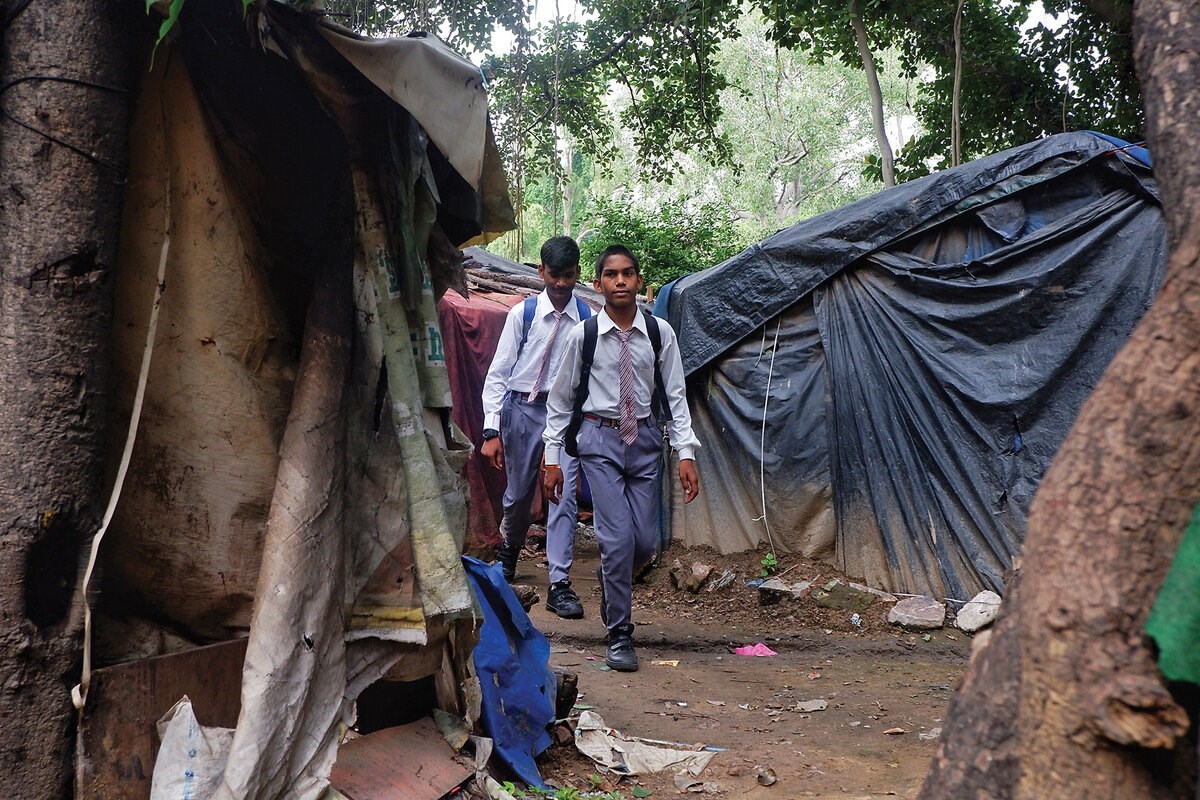REPRINTED WITH PERMISSION FROM THE CHRISTIAN SCIENCE MONITOR
About a third of India’s school-age children don’t attend classes. In Delhi, impoverished kids are learning to love reading and math, thanks to a police officer’s makeshift school.
 SWEET REWARD: Students celebrate a classmate’s birthday at an informal school, or pathshala, set up by Than Singh (center), a Delhi police officer. Shefali Rafiq
SWEET REWARD: Students celebrate a classmate’s birthday at an informal school, or pathshala, set up by Than Singh (center), a Delhi police officer. Shefali Rafiq
|Delhi
For the children living in impoverished areas in the shadow of Delhi’s Red Fort, education was once a distant priority. Their homes are tarpaulin-covered sheds that stand on bamboo sticks, and their parents have few resources. To survive, many of the children beg on the streets, scavenge through trash, or engage in petty crimes.
It wasn’t until Than Singh came along that reading and math became the children’s favorite pastimes. In 2015, the Delhi police officer started a pathshala, or place of learning, where he teaches 80 students a day in a temple set up near the Red Fort. “It was heartbreaking to see children scavenging for plastic bottles in the trash,” he recalls. “That’s when I decided to do something.”
More than half of India’s children are malnourished, and about 30% of those ages 6 to 18 do not attend school. Mr. Singh, who grew up poor in northwestern Rajasthan state, is determined to change these statistics. “My dream is to see every underprivileged child in school,” he says with a broad, charming smile, adding that he is confident that, with God’s help, he will make it happen.
He starts his day early, patrolling the busy lanes of Old Delhi, the capital’s historic heart, as part of his duties. But every day after work, he holds classes at his pathshala, where students eagerly await him. Among them are Ajay Ahirwar and Neelu Ahirwar (no relation).
Ajay says he aspires to become a high-ranking officer in the government so that he can improve the conditions of his family and those living like him. Neelu is fond of her teacher and the pathshala. “I would rather be here, even on holidays, than at home,” says the young girl, who aspires to become an officer in the Indian Police Service.
Initially, only four children attended Mr. Singh’s pathshala. He contributed money from his salary to buy books, notebooks, pencils, and schoolbags. Nine years down the line, he has now taught hundreds of children.
“Beyond basic lessons, I try to instill manners and discipline in these students,” Mr. Singh says. “Even if they come to this school just for a meal, I’ll be happy because, seeing others, they may also want to study.”
Mr. Singh organizes extracurricular activities, too, including cricket. For those children who do attend school in the city, he celebrates good exam results at his pathshala. “I just want these children to stay away from all the bad influences they’re vulnerable to,” he says, referring to the crimes that affect Delhi.
“Our aim in the world is to spread goodness and happiness. The rest, God will take care of.”
 Shefali RafiqVISIONARY: Over the course of nine years, Mr. Singh has taught hundreds of children at his pathshala in Delhi.
Shefali RafiqVISIONARY: Over the course of nine years, Mr. Singh has taught hundreds of children at his pathshala in Delhi. Shefali RafiqPATH TO THE FUTURE: Ajay Ahirwar (front) and Ravi Ahirwar (no relation) walk near their neighborhood in Delhi. “I scored 85% in the recently concluded exams,” Ravi says. “I wish to do better so that I can make [Mr. Singh] proud.”
Shefali RafiqPATH TO THE FUTURE: Ajay Ahirwar (front) and Ravi Ahirwar (no relation) walk near their neighborhood in Delhi. “I scored 85% in the recently concluded exams,” Ravi says. “I wish to do better so that I can make [Mr. Singh] proud.” Shefali RafiqSTANDOUT SCHOLARS: Girls stand for a portrait in their school uniforms. Many of Mr. Singh’s students attend government-run schools, thanks to his efforts.
Shefali RafiqSTANDOUT SCHOLARS: Girls stand for a portrait in their school uniforms. Many of Mr. Singh’s students attend government-run schools, thanks to his efforts. Shefali RafiqCLASS IN SESSION: Mr. Singh teaches at his pathshala. About 30% of Indian children ages 6 to 18 do not attend school.
Shefali RafiqCLASS IN SESSION: Mr. Singh teaches at his pathshala. About 30% of Indian children ages 6 to 18 do not attend school. Shefali RafiqSOLEMN MOMENT: Girls offer morning prayers, which Mr. Singh says are an important part of the pathshala.
Shefali RafiqSOLEMN MOMENT: Girls offer morning prayers, which Mr. Singh says are an important part of the pathshala. Shefali RafiqCHALK OF THE TOWN: Students create rangoli, or colorful floor art. Extracurricular activities are part of the pathshala.
Shefali RafiqCHALK OF THE TOWN: Students create rangoli, or colorful floor art. Extracurricular activities are part of the pathshala.
For more visual storytelling that captures communities, traditions, and cultures around the globe, visit The World in Pictures.
Page created on 12/13/2024 3:07:51 PM
Last edited 12/13/2024 3:18:15 PM
